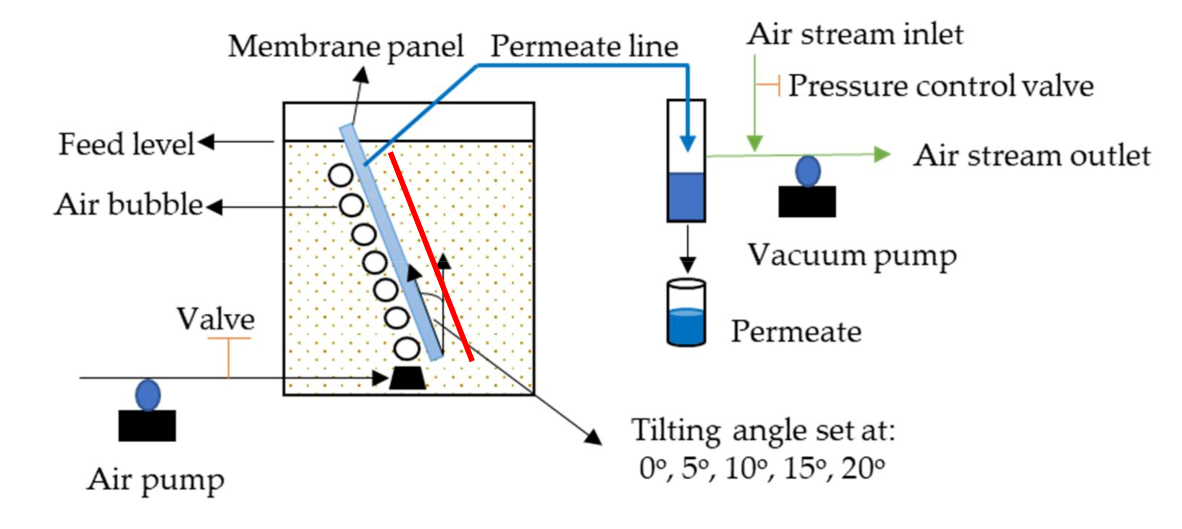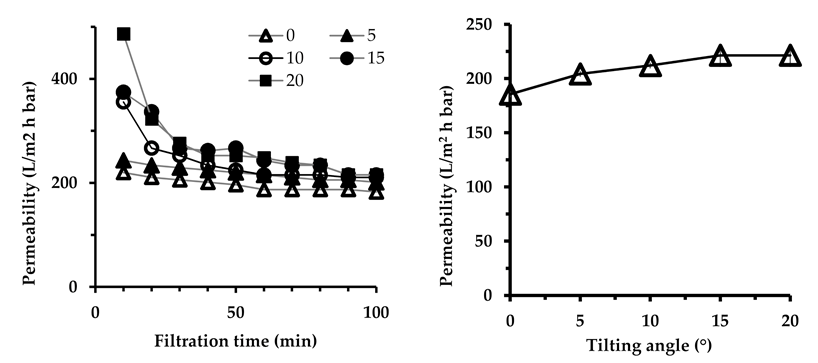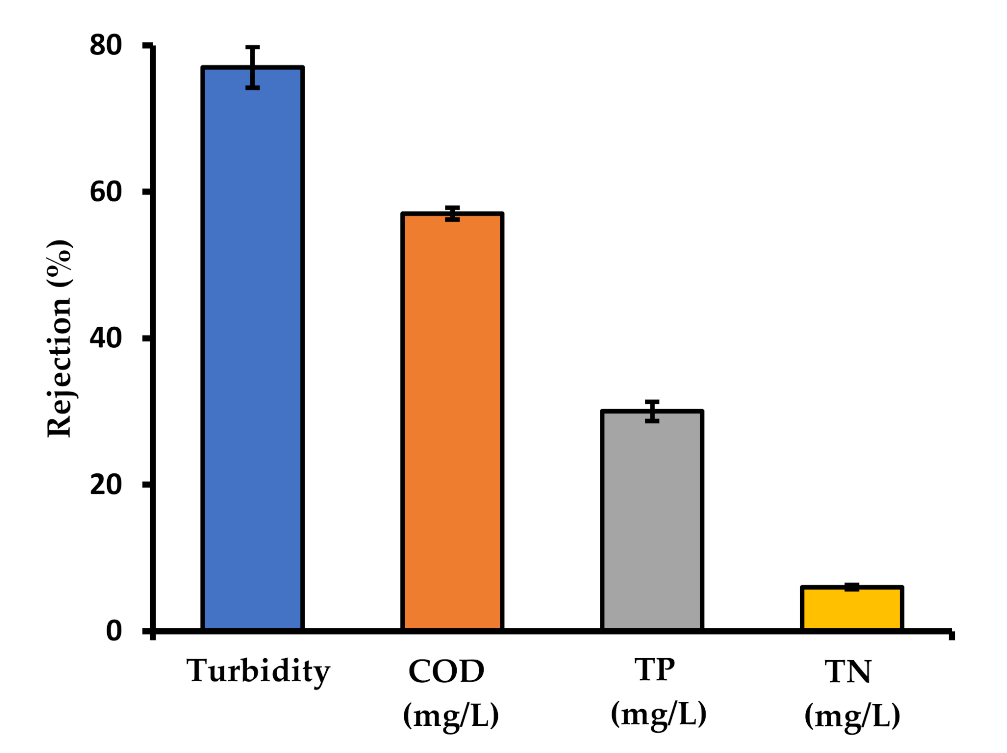Detergent and Water Recovery from Laundry Wastewater Using Tilted Panel Membrane Filtration System
Abstract
1. Introduction
2. Materials and Methods
2.1. Membrane Preparation and Characterization
2.2. Laundry Wastewater and Detergent Recovery Test
2.3. Experimental Set-Up
2.4. Filtration Tests
3. Results and Discussion
3.1. Effect of Tilting Angle
3.2. Effect of Aeration Rate
3.3. Rejection and Detergent Recovery
4. Conclusions
Author Contributions
Funding
Conflicts of Interest
References
- Lyu, S.; Chen, W.; Zhang, W.; Fan, Y.; Jiao, W. Wastewater reclamation and reuse in China: Opportunities and challenges. J. Environ. Sci. (China) 2016, 39, 86–96. [Google Scholar] [CrossRef]
- Asano, T.; Cotruvo, J.A. Groundwater recharge with reclaimed municipal wastewater: Health and regulatory considerations. Water Res. 2004, 38, 1941–1951. [Google Scholar] [CrossRef]
- Giagnorio, M.; Amelio, A.; Grüttner, H.; Tiraferri, A. Environmental impacts of detergents and benefits of their recovery in the laundering industry. J. Clean. Prod. 2017, 154, 593–601. [Google Scholar] [CrossRef]
- Manouchehri, M.; Kargari, A. Water recovery from laundry wastewater by the cross flow microfiltration process: A strategy for water recycling in residential buildings. J. Clean. Prod. 2017, 168, 227–238. [Google Scholar] [CrossRef]
- Sheth, N.; Patel, M.; Desai, M.D. A Study on Characterization & Treatment of Laundry Effluent. Int. J. Innov. Res. Sci. Technol. 2017, 4, 50–55. [Google Scholar]
- Bertrand-Krajewski, J.L. Pharmaceuticals and detergents in hospital and urban wastewater: Comparative monitoring, treatment, and assessment of impacts. Environ. Sci. Pollut. Res. 2018, 25, 9195–9196. [Google Scholar] [CrossRef] [PubMed]
- Šostar-Turk, S.; Petrinić, I.; Simonič, M. Laundry wastewater treatment using coagulation and membrane filtration. Resour. Conserv. Recycl. 2005, 44, 185–196. [Google Scholar] [CrossRef]
- Guilbaud, J.; Massé, A.; Andrs, Y.; Combe, F.; Jaouen, P. Laundry water recycling in ship by direct nanofiltration with tubular membranes. Resour. Conserv. Recycl. 2010, 55, 148–154. [Google Scholar] [CrossRef]
- Sumisha, A.; Arthanareeswaran, G.; Lukka Thuyavan, Y.; Ismail, A.F.; Chakraborty, S. Treatment of laundry wastewater using polyethersulfone/polyvinylpyrollidone ultrafiltration membranes. Ecotoxicol. Environ. Saf. 2015, 121, 174–179. [Google Scholar] [CrossRef]
- Huang, S.; Ras, R.H.A.; Tian, X. Antifouling membranes for oily wastewater treatment: Interplay between wetting and membrane fouling. Curr. Opin. Colloid Interface Sci. 2018, 36, 90–109. [Google Scholar] [CrossRef]
- Marbelia, L.; Bilad, M.R.; Bertels, N.; Laine, C.; Vankelecom, I.F.J. Ribbed PVC-silica mixed matrix membranes for membrane bioreactors. J. Membr. Sci. 2016, 498, 315–323. [Google Scholar] [CrossRef]
- Bilad, M.R. Membrane bioreactor for domestic wastewater treatment: Principles, challanges and future research directions. Indones. J. Sci. Technol. 2017, 2, 97–123. [Google Scholar] [CrossRef]
- Abdel-Karim, A.; Leaper, S.; Alberto, M.; Vijayaraghavan, A.; Fan, X.; Holmes, S.M.; Souaya, E.R.; Badawy, M.I.; Gorgojo, P. High flux and fouling resistant flat sheet polyethersulfone membranes incorporated with graphene oxide for ultrafiltration applications. Chem. Eng. J. 2018, 334, 789–799. [Google Scholar] [CrossRef]
- Chew, N.G.P.; Zhao, S.; Wang, R. Recent advances in membrane development for treating surfactant- and oil-containing feed streams via membrane distillation. Adv. Colloid Interface Sci. 2019, 273, 102022. [Google Scholar] [CrossRef] [PubMed]
- Byhlin, H.; Jönsson, A.S. Influence of adsorption and concentration polarisation on membrane performance during ultrafiltration of a non-ionic surfactant. Desalination 2003, 151, 21–31. [Google Scholar] [CrossRef]
- Ang, W.S.; Lee, S.; Elimelech, M. Chemical and physical aspects of cleaning of organic-fouled reverse osmosis membranes. J. Membr. Sci. 2006, 272, 198–210. [Google Scholar] [CrossRef]
- Goel, G.; Kaur, S. A Study on Chemical Contamination of Water Due to Household Laundry Detergents. J. Hum. Ecol. 2012, 38, 65–69. [Google Scholar] [CrossRef]
- Abd El-Gawad, H.S. Aquatic environmental monitoring and removal efficiency of detergents. Water Sci. 2014, 28, 51–64. [Google Scholar] [CrossRef]
- Sadeghi, I.; Aroujalian, A.; Raisi, A.; Dabir, B.; Fathizadeh, M. Surface modification of polyethersulfone ultrafiltration membranes by corona air plasma for separation of oil/water emulsions. J. Membr. Sci. 2013, 430, 24–36. [Google Scholar] [CrossRef]
- Shang, X.; Kim, H.C.; Huang, J.H.; Dempsey, B.A. Coagulation strategies to decrease fouling and increase critical flux and contaminant removal in microfiltration of laundry wastewater. Sep. Purif. Technol. 2015, 147, 44–50. [Google Scholar] [CrossRef]
- Ding, Y.; Maruf, S.; Aghajani, M.; Greenberg, A.R. Surface patterning of polymeric membranes and its effect on antifouling characteristics. Sep. Sci. Technol. 2017, 52, 240–257. [Google Scholar] [CrossRef]
- Elsherbiny, I.M.A.; Khalil, A.S.G.; Ulbricht, M. Influence of surface micro-patterning and hydrogel coating on colloidal silica fouling of polyamide thin-film composite membranes. Membranes 2019, 9, 67. [Google Scholar] [CrossRef] [PubMed]
- Eliseus, A.; Bilad, M.R.; Nordin, N.A.H.M.; Putra, Z.A.; Wirzal, M.D.H. Tilted membrane panel: A new module concept to maximize the impact of air bubbles for membrane fouling control in microalgae harvesting. Bioresour. Technol. 2017, 241, 661–668. [Google Scholar] [CrossRef] [PubMed]
- Watabe, T.; Matsuyama, K.; Takahashi, T.; Matsuyama, H. Use of microbubbles to reduce membrane fouling during water filtration. Desalination Water Treat. 2016, 57, 3820–3826. [Google Scholar] [CrossRef]
- Jhaveri, J.H.; Murthy, Z.V.P. A comprehensive review on anti-fouling nanocomposite membranes for pressure driven membrane separation processes. Desalination 2016, 379, 137–154. [Google Scholar] [CrossRef]
- Bokhary, A.; Tikka, A.; Leitch, M.; Liao, B. Membrane fouling prevention and control strategies in pulp and paper industry applications: A review. J. Membr. Sci. and Res. 2018, 4, 181–197. [Google Scholar] [CrossRef]
- Ciabattia, I.; Cesaro, F.; Faralli, L.; Fatarella, E.; Tognotti, F. Demonstration of a treatment system for purification and reuse of laundry wastewater. Desalination 2009, 245, 451–459. [Google Scholar] [CrossRef]
- Bilad, M.R.; Mat Nawi, N.I.; Subramaniam, D.D.; Shamsuddin, N.; Khan, A.L.; Jaafar, J.; Nandiyanto, A.B.D. Low-pressure submerged membrane filtration for potential reuse of detergent and water from laundry wastewater. J. Water Process Eng. 2020, 36, 101264. [Google Scholar] [CrossRef]
- Kim, H.C.; Shang, X.; Huang, J.H.; Dempsey, B.A. Treating laundry waste water: Cationic polymers for removal of contaminants and decreased fouling in microfiltration. J. Membr. Sci. 2014, 456, 167–174. [Google Scholar] [CrossRef]
- Hamedi, H.; Ehteshami, M.; Mirbagheri, S.A.; Rasouli, S.A.; Zendehboudi, S. Current Status and Future Prospects of Membrane Bioreactors (MBRs) and Fouling Phenomena: A Systematic Review. Can. J. Chem. Eng. 2019, 97, 32–58. [Google Scholar] [CrossRef]
- Kim, I.; Choi, D.C.; Lee, J.; Chae, H.R.; Hee Jang, J.; Lee, C.H.; Park, P.K.; Won, Y.J. Preparation and application of patterned hollow-fiber membranes to membrane bioreactor for wastewater treatment. J. Membr. Sci. 2015, 490, 190–196. [Google Scholar] [CrossRef]
- Bagheri, M.; Mirbagheri, S.A. Critical review of fouling mitigation strategies in membrane bioreactors treating water and wastewater. Bioresour. Technol. 2018, 258, 318–334. [Google Scholar] [CrossRef] [PubMed]
- Eliseus, A.; Putra, Z.A.; Bilad, M.R.; Nordin, N.A.H.M.; Wirzal, M.D.H.; Jaafar, J.; Khan, A.L. Aqsha Energy minimization of a tilted panel filtration system for microalgae filtration: Performance modeling and optimization. Algal Res. 2018, 34, 104–115. [Google Scholar] [CrossRef]
- Osman, A.; Mat Nawi, N.I.; Samsuri, S.; Bilad, M.R.; Shamsuddin, N.; Khan, A.L.; Jaafar, J.; Nordin, N.A.H. Patterned membrane in an energy-efficient tilted panel filtration system for fouling control in activated sludge filtration. Polymers 2020, 12, 432. [Google Scholar] [CrossRef] [PubMed]
- Lau, A.K.S.; Bilad, M.R.; Nordin, N.A.H.M.; Faungnawakij, K.; Narkkun, T.; Wang, D.K.; Mahlia, T.M.I.; Jaafar, J. Effect of membrane properties on tilted panel performance of microalgae biomass filtration for biofuel feedstock. Renew. Sust. Energ. Rev. 2020, 120, 109666. [Google Scholar] [CrossRef]




| Parameter | Laundry Wastewater Sample |
|---|---|
| Chemical oxygen demand (mg/L) | 93.5 |
| Total phosphorous (mg/L) | 0.745 |
| Total nitrogen (mg/L) | 17.8 |
| Turbidity (NTU) | 2.185 |
| Membranes | Pre-Treatment | COD Removal (%) | Turbidity Removal (%) | References |
|---|---|---|---|---|
| MF | None | 57 ± 0.8 | 77 ± 2.8 | This study |
| MF | COAG | 61.0 | 100 | [20] |
| UF | GACF | 87.0 | 99.0 | [27] |
| NF | None | 97.0 | 98.0 | [8] |
| MF | DF | 90.0 | 98.4 | [4] |
| UF | None | 88.0 | 98.4 | [9] |
© 2020 by the authors. Licensee MDPI, Basel, Switzerland. This article is an open access article distributed under the terms and conditions of the Creative Commons Attribution (CC BY) license (http://creativecommons.org/licenses/by/4.0/).
Share and Cite
Barambu, N.U.; Peter, D.; Yusoff, M.H.M.; Bilad, M.R.; Shamsuddin, N.; Marbelia, L.; Nordin, N.A.H.; Jaafar, J. Detergent and Water Recovery from Laundry Wastewater Using Tilted Panel Membrane Filtration System. Membranes 2020, 10, 260. https://doi.org/10.3390/membranes10100260
Barambu NU, Peter D, Yusoff MHM, Bilad MR, Shamsuddin N, Marbelia L, Nordin NAH, Jaafar J. Detergent and Water Recovery from Laundry Wastewater Using Tilted Panel Membrane Filtration System. Membranes. 2020; 10(10):260. https://doi.org/10.3390/membranes10100260
Chicago/Turabian StyleBarambu, Nafiu Umar, Derrick Peter, Mohd Hizami Mohd Yusoff, Muhammad Roil Bilad, Norazanita Shamsuddin, Lisendra Marbelia, Nik Abdul Hadi Nordin, and Juhana Jaafar. 2020. "Detergent and Water Recovery from Laundry Wastewater Using Tilted Panel Membrane Filtration System" Membranes 10, no. 10: 260. https://doi.org/10.3390/membranes10100260
APA StyleBarambu, N. U., Peter, D., Yusoff, M. H. M., Bilad, M. R., Shamsuddin, N., Marbelia, L., Nordin, N. A. H., & Jaafar, J. (2020). Detergent and Water Recovery from Laundry Wastewater Using Tilted Panel Membrane Filtration System. Membranes, 10(10), 260. https://doi.org/10.3390/membranes10100260








